Pigeon removal services
- Home
- Pigeon removal services
We are a Pigeon and Bird Control Company
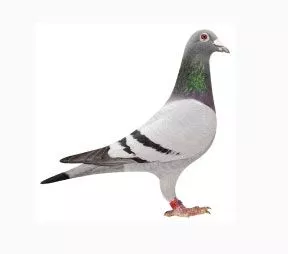
Our Bird Barrier and Bird-B-Gone certified pest bird control installers, many with 5 – 15 + years of experience, have been providing humane, discreet, and guaranteed pigeon removal deterrents and pest bird control solutions to Arizona homes, businesses, industrial buildings, state and government buildings throughout Arizona with over 18,000 projects completed since 1997 by our Bird Barrier and Bird-B-Gone certified installers.
Most all of our installers are OSHA 10 or OSHA 30 certified and have been trained in lift, ladder, roof top fall protection and tie off methods to help keep them safe while working on your home or business.
Southwest Avian Solutions can handle pest bird problems on all types of buildings and structures. Our knowledge about bird behaviors has been developed over many years and the experience of bird proofing thousands of structures, building construction knowledge, understanding of environmental sensitivity issues.
All our pigeon removal service specialists take immense pride in their workmanship providing long lasting and humane solutions which make us the right choice for all your Arizona bird control needs.
Call Now, Put An End To Your Bird Control Problems
We offer a quality, long lasting and guaranteed pigeon control or bird removal service.
We are reasonably priced, provide contact-less inspections which is sent to your email before we leave.
Due to our many years of experience, Southwest Avian Solutions can offer very competitive prices for your home, office, or structure’s bird control problems without compromising integrity or quality, backed by our 3 – 5 year Bird-Free Guarantee.
Don’t wait any longer, call Southwest Avian Solutions, LLC. Monday through Saturday from 8:00 AM – 5:00 PM at 602-942-6550 or 480-969-2337 to schedule your FREE, NO OBLIGATION, ONSITE CONSULTATION.
We can solve your pigeon or pest bird problems with our many different discreet bird deterrents. Bird proofing your residential or commercial property will help you finally put an end to all the hassle, mess, and health issues caused by your pest birds or pigeons on your home or business.


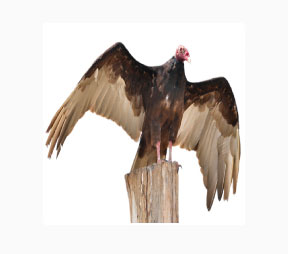 The Turkey Vulture does not win any beauty contests. The birds’ shape and head look similar to a turkey, with a red head and dark body feathers.
The Turkey Vulture does not win any beauty contests. The birds’ shape and head look similar to a turkey, with a red head and dark body feathers.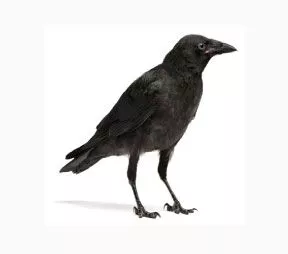
 By definition, Canadian Geese are not classified as pest birds and are afforded protection by federal and state agencies. Nonetheless, Canadian Geese are increasingly becoming the scourge of suburbia as their numbers have grown in the past decade from only a few thousand to hundreds of thousands of these birds.
By definition, Canadian Geese are not classified as pest birds and are afforded protection by federal and state agencies. Nonetheless, Canadian Geese are increasingly becoming the scourge of suburbia as their numbers have grown in the past decade from only a few thousand to hundreds of thousands of these birds.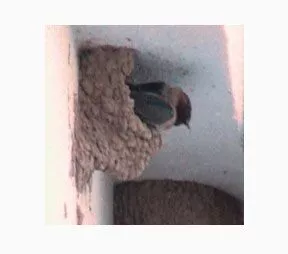 These sleek little birds are well known for their long migration and nesting habits. Cliff and Barn Swallows spend their winters in South America and summers in North America. They arrive around March in the southern part of the country, reaching the northern states in April. Swallows are very territorial and will always come back to the same nesting site. Swallows have made a very successful switch from cliffs and caves to man made structures for placement of their mud pellet nests.
These sleek little birds are well known for their long migration and nesting habits. Cliff and Barn Swallows spend their winters in South America and summers in North America. They arrive around March in the southern part of the country, reaching the northern states in April. Swallows are very territorial and will always come back to the same nesting site. Swallows have made a very successful switch from cliffs and caves to man made structures for placement of their mud pellet nests.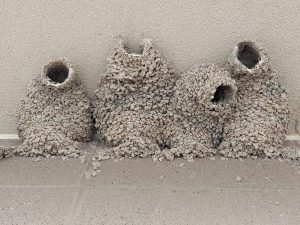 from the bird colony along with collecting on the ground. Homeowners have also reported problems with parasites entering the house through building cracks next to the nests which poses a potential health risk to humans and animals.
from the bird colony along with collecting on the ground. Homeowners have also reported problems with parasites entering the house through building cracks next to the nests which poses a potential health risk to humans and animals. Grackles are boisterous, abundant members of the Troupial Family. The common grackle has a green,blue, or purple iridescent tinted black plumage with a glossy purplish head, neck, and breast with the female of the species, slightly smaller and duller colored.
Grackles are boisterous, abundant members of the Troupial Family. The common grackle has a green,blue, or purple iridescent tinted black plumage with a glossy purplish head, neck, and breast with the female of the species, slightly smaller and duller colored.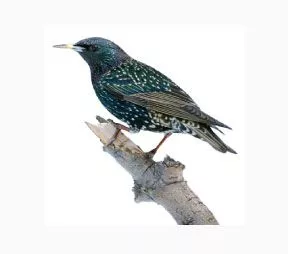 Like the House Sparrow, the Starling was introduced from Europe in the 19th century. However, it did not spread as fast and only reached the western coast within the last few decades.
Like the House Sparrow, the Starling was introduced from Europe in the 19th century. However, it did not spread as fast and only reached the western coast within the last few decades.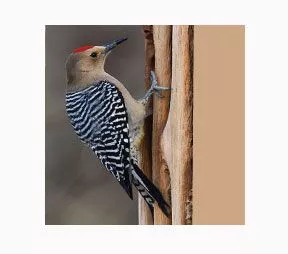 Woodpeckers primarily feed on wood-boring insects using their strong beak and long tongue to dislodge food. Some members of the Woodpecker Family (Flickers) feed on insects of the ground, while others prefer native berries, fruits, and nuts.
Woodpeckers primarily feed on wood-boring insects using their strong beak and long tongue to dislodge food. Some members of the Woodpecker Family (Flickers) feed on insects of the ground, while others prefer native berries, fruits, and nuts.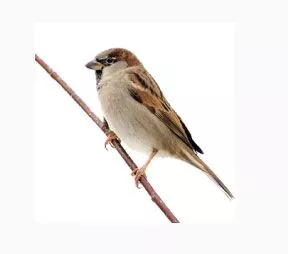 The House Sparrow is the number two urban pest bird. Introduced as a species to North America, the house sparrow quickly spread across the country due to its lack of natural enemies and its adaptive traits. Its ability to nest in urban structures, eat urban scraps, and a large breeding capacity are some of these adaptive traits.
The House Sparrow is the number two urban pest bird. Introduced as a species to North America, the house sparrow quickly spread across the country due to its lack of natural enemies and its adaptive traits. Its ability to nest in urban structures, eat urban scraps, and a large breeding capacity are some of these adaptive traits.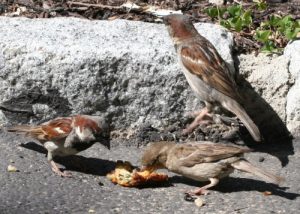 eaves of houses.
eaves of houses. Feral Pigeons (Columbia Livia) are the number one urban pest bird, causing damage where ever they nest or roost. Pigeons are descendants of domesticated European Homing Pigeons or Rock Doves, so they have a varied diet and feel at ease making their homes in man-made structures, they also lay 2 – 3 eggs every 3 or 4 months all year long in Arizona.
Feral Pigeons (Columbia Livia) are the number one urban pest bird, causing damage where ever they nest or roost. Pigeons are descendants of domesticated European Homing Pigeons or Rock Doves, so they have a varied diet and feel at ease making their homes in man-made structures, they also lay 2 – 3 eggs every 3 or 4 months all year long in Arizona. units, roof line overhangs, solar panels or even wide window sills.
units, roof line overhangs, solar panels or even wide window sills.